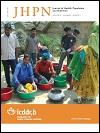Factors Influencing Peoples Willingness-to-buy Insecticide-treated Bednets in Arbaminch Zuria District, Southern Ethiopia
DOI:
https://doi.org/10.3329/jhpn.v29i3.7867Keywords:
Community-based studies, Cross-sectional studies, Insecticide-treated bednets, User-fee, Malaria, Willingness-to-pay, EthiopiaAbstract
Promoting self-financing healthcare helps restore efficiency and equity to national health systems. This study was conducted in malaria-endemic areas of southern Ethiopia to assess the bednet possession of the community, determine the people’s willingness-to-pay for insecticide-treated bednets (ITNs), and identify what factors influence it. The study provided relevant information for programme planners and policymakers for evidence-based decision-making. This quantitative cross-sectional community-based study was conducted in four selected malarious Kebeles of Arbaminch Zuria district using a pretested interview-administered structured questionnaire. In total, 982 household heads were interviewed. The community’s willingness-to-pay was assessed by contingent valuation technique using binary with follow-up method. The advantage, the distribution, and the payment mechanism were explained, and three different qualities of ITN were shown by constructing a hypothetical market scenario. Of the 982 respondents, 466 (47.5%) households had at least one functional bednet. Of 849 children aged less than five years in the 982 households, 185 (21.8%) slept under a net the night preceding the survey. The results of the study revealed that around 86% of the respondents were willing to buy ITNs. The average maximum willingness-to-pay for three different types of bednets was statistically different. The maximum amount the people were willing to pay was US$ 3.3 for a blue conical ITN, US$ 3.2 for a white conical one, and US$ 1.7 for a blue rectangular ITN. The community’s willingness-to-pay was significantly affected by gender, educational status, perceived benefit of ITN, previous source of bednet, and characteristics of bednet. The results showed that a significant proportion of the community people were willing to pay for ITNs. Therefore, introducing a subsidized ITN market rather than free distribution for all should be considered to ensure sustainability and self-reliance in the prevention and control of malaria.
Key words: Community-based studies; Cross-sectional studies; Insecticide-treated bednets; User-fee; Malaria; Willingness-to-pay; Ethiopia
DOI: http://dx.doi.org/10.3329/jhpn.v29i3.7867
J HEALTH POPUL NUTR 2011 Jun;29(3):200-206
Downloads
259
189

